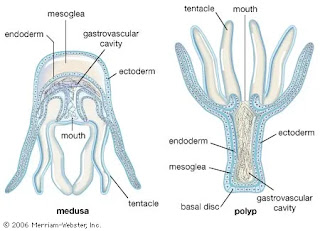Phylum Cnidaria – Complete Notes
1. Habitat
- Mostly Marine: Almost all cnidarians live in saltwater.
- Some Freshwater Species: A few are found in freshwater, e.g., Hydra, some Jellyfish.
https://www.britannica.com/2. Body Structure
- Radial Symmetry
- Diploblastic:
- Epidermis (from ectoderm)
- Gastrodermis (from endoderm)
- Mesoglea: A jelly-like layer between epidermis and gastrodermis, sometimes with amoeboid cells.
3. Special Cells
- Cnidocytes: Stinging cells unique to cnidarians.
- Nematocysts: Organelles inside cnidocytes used for defense and capturing prey.
4. Digestive System
- Gastrovascular Cavity (Enteron) with a single opening (mouth = anus).
- Tentacles around the mouth help in prey capture.
- Sac-like Digestive System: Because there is only one opening for both ingestion and egestion.
5. Nervous System
- Nerve Net in the body wall.
- No Central Nervous System (no brain or spinal cord).
6. No Other Systems
- No Respiratory, Excretory, or Circulatory Systems
7. Body Forms
Cnidarians exist in two body forms:
🔸 Polyp
- Cylindrical shape
- Sessile (attached to a surface)
- Aboral End: The end opposite the mouth, which is attached to the substrate.
✅ Explanation: The polyp has two ends — the oral end (with mouth and tentacles) and the aboral end, which is fixed to a surface like a rock or coral.
- Reproduces asexually
- Examples: Hydra, Corals, Obelia
🔸 Medusa
- Umbrella-shaped
- Motile (free-swimming)
- Oral end faces downward
- Reproduces sexually
- Example: Jellyfish

0 Comments